|
|
|
Your search within this document for 'set,timbal' resulted in ten matching pages.
|
| 1 |
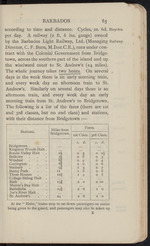 |
“...class) and stations,
with their distance from Bridgetown :—
Stations. Miles from Fares.
Bridgetown. 1st Class. 3rd Class.
Bridgetown . s. d. s. d.
Kingston Woods Halt. ... ...
Rouen Valley Halt 0 3 0 1$
Bulkeley 0 6 0 3
Windsor 0 9 0 4
Carrington . 81 1 0 0 6
Sunbury 9Ï 1 3 0 7
Bushy Park . II 1 6 0 8
Three Houses I2f i 9 0 8
College Siding Halt
Bath .... 15Ï 2 0 0 10
Martin's Bay Halt Bathsheba . 19I 2 6 1 0
Joe's River Halt .
St. Andrew’s 24 2 6 1 0
At the “ Halts,” trains stop to set down passengers on notice
being given to the guard, and passengers may also be taken up
£...”
|
|
| 2 |
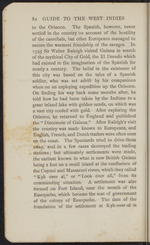 |
“...82 GUIDE TO THE WEST INDIES
to the Orinoco. The Spanish, however, never
settled in the country on account of the hostility
of the cannibals, but other Europeans managed to
secure the warmest friendship of the savages. In
1595 Sir Walter Raleigh visited Guiana in search
of the mythical City of Gold, the El Dorado which
had existed in the imagination of the Spanish for
nearly a century. The belief in the existence of
this city was based on the tales of a Spanish
soldier, who was set adrift by his companions
when on an exploring expedition up the Orinoco.
On finding his way back some months after, he
told how he had been taken by the Indians to a
great inland lake with golden sands, on which was
a vast city roofed with gold. After exploring the
Orinoco, he returned to England and published
the “ Discoverie of Guiana.” After Raleigh’s visit
the country was made known to Europeans, and
English, French, and Dutch traders were often seen
on the coast. The Spaniards tried to drive them
away, and...”
|
|
| 3 |
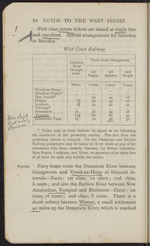 |
“...town. Fares from Georgetown.
1st Single. 1st Return. 2nd Single.
Miles. Cents. Cents. Cents.
Vreed-en-Hoop . ...
Windsor Forest*
Den Amstel* 32 42 16
Hague 3* 42 16
Leonora 4 42 56 20
Uitvlugt* .
Boeraserie . 12 56 74 28
TusgJjgn 13J 60 80
Greenwich Park. is 72 96 36
* Trains stop at these stations by signal, or on informing
the conductor at the preceding station. The fare from the
preceding station is charged. On the Demerara and Berbice
Railway passengers may be taken up or set down at any of the
customary side lines, namely, Success, La Bonne Intention,
Mon Repos, Lusignan, and Hope, on payment of an extra fare
of 48 cents for each stop outside the station.
Ferries. Ferry-boats cross the Demerara River between
Georgetown and Vreed-en-Hoop at frequent in-
tervals—Fares: 1st class, 12 cents; 2nd class,
8 cents ; and also the Berbice River between New
Amsterdam, Rosignol and Blairmont—Fares : 1st
class, 16 cents; 2nd class, 8 cents. There is a
short railway between Wismar...”
|
|
| 4 |
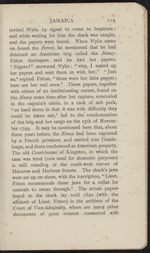 |
“...was with difficulty they
could be taken out,” led to the condemnation
of the brig and her cargo on the 25 th of Novem-
ber 1799. It may be mentioned here that, about
three years before, the Nancy had been captured
by a French privateer, and carried into Guade-
loupe, and there condemned as American property.
The old Court-house of Kingston, in which the
case was tried (now used for domestic purposes)
is still standing at the south-west corner of
Hanover and Harbour Streets. The shark s jaws
were set up on shore, with the inscription, “ Lieut.
Fitton recommends these jaws for a collar for
neutrals to swear through.” The actual papers
found in the shark lay until 1890 (with the
affidavit of Lieut. Fitton) in the archives of the
Court of Vice-Adnjiralty, where are many other
documents of great interest connected with...”
|
|
| 5 |
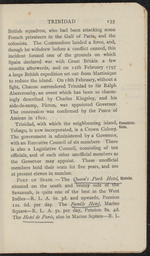 |
“...TRINIDAD
135
British squadron, who had been attacking some
French privateers in the Gulf of Paria, and the
colonists. The Commodore landed a force, and,
though he withdrew before a conflict ensued, this
incident formed one of the grounds on which
Spain declared war with Great Britain a few
months afterwards, and on 12th February 1797
a large British expedition set out from Martinique
to reduce the island. On 18th February, without a
fight, Chacon surrendered Trinidad to Sir Ralph
Abercromby, an event which has been so charm-
ingly described by Charles Kingsley, and his
aide-de-camp, Picton, was appointed Governor.
The concession was confirmed by the Peace of
Amiens in 1802.
Trinidad, with which the neighbouring island, Constitu-
Tobago, is now incorporated, is a Crown Colony.
The government is administered by a Governor,
with an Executive Council of six members. There
is also a Legislative Council, consisting of ten
officials, and of such other unofficial members as
the Governor may appoint...”
|
|
| 6 |
 |
“...TOBAGO
*53
These valleys are very fertile, each having its
own stream. The central portion is undulating,
with little valleys and conical hills, and the south
end is quite flat. About 53,000 acres are owned
privately; 6360 acres in the north are set apart
as a rain and forest reserve, and the remaining
13,640 acres are Crown lands available for sale.
The chief areas of cultivation are on the south
side, on which the slopes of the hills are less
steep than in the north. Scarborough (popula-
tion 2500), the capital of Tobago, is situated
at the south of the island, about 8 miles from
the south-west point. The only other town is
Plymouth, really only a village (population 1200),
on the north side, 5 miles from Scarborough.
Around the coast there are many excellent bays,
most of which are well sheltered and afford safe
anchorage with deep soundings. Indeed, Man-
o’-War Bay, a very spacious harbour, is said to
be capable of affording shelter to the whole of the
British fleet! What is most wanted...”
|
|
| 7 |
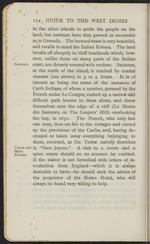 |
“...Italian
Sauteurs. coast, are densely covered with verdure. Sauteurs,
at the north of the island, is reached by coastal
steamer (see above) in 3 or 4 hours. It is of
interest as being the scene of the massacre of
Carib Indians, of whom a number, pursued by the
French under Le Compte, rushed up a narrow and
difficult path known to them alone, and threw
themselves over the edge of a cliff (Le Morne
des Sauteurs, or The Leapers’ Hill) overlooking
the bay, in 1650. The French, who only lost
one man, then set fire to the cottages and rooted
up the provisions of the Caribs, and, having de-
stroyed or taken away everything belonging to
them, returned, as Du Tertre naively describes
Cocoa and it, “ bien joyeux.” A visit to a cocoa and a
Estates, spice estate should on no account be omitted.
If the visitor is not furnished with letters of in-
troduction from England—which it is always
desirable to have—he should seek the advice of
the proprietor of the Home Hotel, who will
always be found very willing to...”
|
|
| 8 |
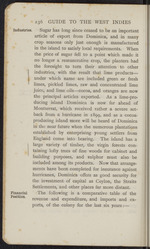 |
“...satisfy local requirements. When
the price of sugar fell to a point which made it
no longer a remunerative crop, the planters had
the foresight to turn their attention to other
industries, with the result that lime products—
1 under which name are included green or fresh
' limes, pickled limes, raw and concentrated lime
juice, and lime oils—cocoa, and oranges are now
the principal articles exported. As a lime-pro-
ducing island Dominica is now far ahead of
Montserrat, which received rather a severe set-
back from a hurricane in 1899, and as a cocoa-
producing island more will be heard of Dominica
in the near future when the numerous plantations
established by enterprising young settlers from
England come into bearing. The island has a
1 large variety of timber, the virgin forests con-
taining lofty trees of fine woods for cabinet and
building purposes, and sulphur must also be
included among its products. Now that arrange-
ments have been completed for insurance against
hurricanes, Dominica offers...”
|
|
| 9 |
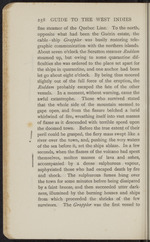 |
“... with the northern islands.
About seven o’clock the Scrutton steamer Roddam
steamed up, but owing to some quarantine dif-
ficulties she was ordered to the place set apart for
the ships in quarantine, and one anchor had been
let go about eight o’clock. By being thus moored
slightly out of the full force of the eruption, the
Roddam probably escaped the fate of the other
vessels. In a moment, without warning, came the
awful catastrophe. Those who survived stated
that the whole side of the mountain seemed to
gape open, and from the fissure belched a lurid
whirlwind of fire, wreathing itself into vast masses
of flame as it descended with terrible speed upon
the doomed town. Before the true extent of their
peril could be grasped, the fiery mass swept like a
« river over the town, and, pushing the very waters
of the sea before it, set the ships ablaze. In a few
seconds, when the flames of the volcano had spent
I themselves, molten masses of lava and ashes,
accompanied by a dense sulphurous vapour...”
|
|
| 10 |
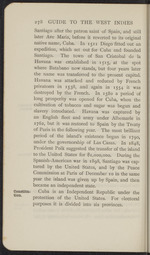 |
“...Constitu-
tion.
278 GUIDE TO THE WEST INDIES
Santiago after the patron saint of Spain, and still
later Ave Maria, before it reverted to its original
native name, Cuba. In 1511 Diego fitted out an
expedition, which set out for Cuba and founded
Santiago. The town of San Cristobal de la
Havana was established in 1515, at the spot
where Batabano now stands, but four years later
the name was transferred to the present capital.
Havana was attacked and reduced by French
privateers in 1538, and again in 1554 it was
destroyed by the French. In 1580 a period of
long prosperity was opened for Cuba, when the
cultivation of tobacco and sugar was begun and
slavery introduced. Havana was captured by
an English fleet and army under Albemarle in
1762, but it was restored to Spain by the Treaty
of Paris in the following year. The most brilliant
period of the island’s existence began in 1790,
under the governorship of Las Casas. In 1848,
President Polk suggested the transfer of the island
to the United States...”
|
|
|
